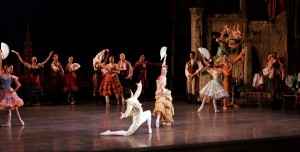Posted April 21, 2014
By VICTORIA HERNANDEZ
Fans were flapping and capes were flying for the Miami City Ballet’s vivacious production of “Don Quixote” in mid-April. The fourth and final program of the 2013-14 season had the audience leaving the Adrienne Arsht Center beaming after a whirlwind back in time.
The Sunday matinee opens appropriately with a screen covered in a picture of a yellow fan decorated with illustrations of life in Spain during the 1600s.
Guided by a spotlight, different characters are introduced including the legendary Don Quixote, who is struck by an arrow from the goddess Amour. He then sets off on a journey to find his true love. The screen rises and the ballet begins in the town of Seville. Everyone is bustling about, dancing and enjoying life.
Kitri is lively and flirtatious. Jennifer Lauren, making her role debut, does a great job with her character. She is full of energy and woos the audience with the traditional 32 fouettés in the third act. Her extensions are flawless, but aren’t exceptionally impressive like some of the ballerinas whose legs seem to go on forever. Nevertheless, she satisfies as the beautiful lead ballerina.
Basilio, her lover is bold and matches Kitri’s energy perfectly. Kleber Rebello also makes his debut role. His leaps and turns are incredible. He is also a great actor and had the audience howling with laughter when, to win the blessing of Kitri’s father, he pretends to commit suicide.
He whirls around carelessly with a razor and then carefully lays down his cape before falling dramatically onto the floor. The entire story walks the fine line between comical fantasy and romantic reality.
Espada, the lead matador, and Mercedes, his lover, are powerful additions to the cast. Carlos Miguel Guerra plays the proud bullfighter and Callie Manning is his lovely companion. They do not add much to the story, but their energy and technique are impeccable.
Even though she is only on stage for a few brief glimpses, the goddess Amour is sprightly and adorable. Sara Esty flits around the stage effortlessly and wins the audience’s heart.
The story is split into three acts. The Miami City Ballet does a superb job contrasting the three settings of Seville, a gypsy camp and a dream scene. The town square is bright and colorful. The set features traditional Spanish architecture. The ballerinas wear traditional Spanish dresses. The advertisements for “Don Quixote” promised plenty of swirling skirts, but there aren’t as many whirling turns as expected.
The gypsy camp is darker but freer. There is a windmill in the back of the stage that becomes pivotal to the story, but the audience seated high in the auditorium could not see this important part of the narrative. All the dancers in the gypsy camp are barefoot and the women wear their hair down and flowing. This is a stark contrast to the pointe shoes and the stiff buns worn by Kitri and all the ballerinas in Seville.
Finally, the dream scene was beautiful and ethereal, more like the traditional fairy tale ballets. The lighting was whitewashed and the costumes were bluish-grey. This was the only time the audience got to see tutus, which were exquisite. Santo Loquasto, from the American Ballet Theatre, designed all of the costumes and scenery.
As beautiful as the costumes, scenery and main dancers were, the show was not exactly perfect. The toreadors, or bullfighters, are an exciting part of the performance because it is rare for ballet to have so many male dancers. But they weren’t completely synchronized, which took away from their power and bravado. Also, the lead bridesmaid, played by Leigh-Ann Esty, was a little sloppy. She wobbled during her tour jetés in her solo. Fortunately, these were minor details that didn’t really affect the flow of the show.
The man himself, Don Quixote, is quirky and entertaining. He walked around half in a trance trying to find his lover, for whom he mistakes Kitri. Kitri does a good job of playing along while promising Basilio that he is the one who truly holds her heart. The other theatrical characters all did a good job as well.
Sancho Panza, Don Quixote’s sidekick, is utterly hilarious. He flops around and is an easy target for the people in the town to make fun of. Gamache, an obnoxious nobleman who wants to marry Kitri, is well… obnoxious as he struts around in his bright blue outfit.
The score, originally composed by Léon Minkus in 1869, is just as lively as the handful of twirling skirts. It definitely helps transport the audience across the Atlantic Ocean. Spain is brought to Miami with clinking castanets and bold horns. A duet in the third act with Espada and Mercedes is filled with extra spicy flavor. Mercedes ends the piece dramatically falling to her knees as in a Paso Doble.
“Don Quixote” was a delightful production. The Miami City Ballet, which performed its first show in 1986, is still a relatively young company and, after a great foundation set by Edward Villella, has a lot of room to grow under new artistic director Lourdes Lopez. The dancers reflect the diversity of the city and their energy and enthusiasm promises a bright future.
- “Don Quixote”
- Miami City Ballet
- Dancers: Jennifer Lauren, Kleber Rebello, Sara Esty, Reyneris Reyes, Callie Manning, Carlos Miguel Guerra
- Choreography: Marius Petipa and Alexander Gorsky
- Music: Léon Minkus
- Based on the book Don Quixote by Miguel de Cervantes

